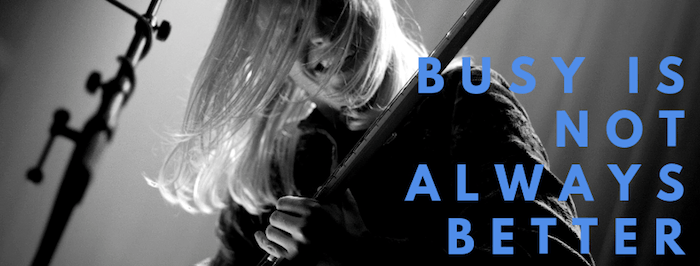
One sign of true musicianship is self-control, especially in the context of a worship service. You can almost always tell the difference between a pro and an amateur because a pro paces themselves and waits for the right moment to play something flashy or busy. They have embraced that less is more. The amateur, on the other hand, lets it all out right out of the gate. Today, we’re checking out a couple reasons why busy is not always better.
1. Too much clutter
A general rule of thumb is the more members you add to your band, the less you should be playing. If everyone on stage is competing for real estate in the audience’s/congregation’s ears, it can feel a bit obnoxious and overwhelming.
It is important that every member knows their role in the band and does their best to exercise good musicianship.
Generally speaking, the drums and bass are to provide the rhythmic and harmonic foundation for the rest of the band to build on.
The keyboard usually adds a little more harmonic context, filling out the space between the bass and the melody. I’ve found that in many situations, the keyboard does not need to play very rhythmically, even in more energetic sections of a song.
The acoustic guitar, like the keyboard, adds some chordal context. It is also a very percussive instrument in nature so it generally reinforces what the drummer is also playing.
The electric guitar is typically the icing on the cake, used to grab the listener’s attention. It can be used to play chord swells like a keyboard pad, play big open chords to lift the song up, or even play a catchy hook that people can recognize to identify where you’re at in the song.
Background vocals/choir also provide harmonic context. They reinforce the chords being played by the other instruments while acting as a boost for the lead vocal. This means to save the runs for another day! No one likes hearing that one guy constantly trying to overpower the lead singer.
Lead vocals are usually the main focus of a song, providing the melody. This is the part that people find themselves singing along to in their cars. This doesn’t give the lead singer an excuse to not use musicianship and taste. The lead singer still needs to support the song and sing in the style of that song.
These are — of course — all generalizations. This is just to give you a basic idea of what each instrument’s typical role is as a foundation and you can go from there.

2. No room to grow
Music should be like nature, which has peaks and valleys. If every band member is constantly playing at the song’s dynamic peak, there is no room for the song to grow. You can’t take your audience anywhere because you’re already there. Here are some practical tips you can use to make your music sound more… musical.
i. Don’t play.
There’s no better way to ensure that there is room to add energy than to lay out entirely. Sometimes, dynamic shifts happen from adding/subtracting instruments rather than to actually change the volume each person plays at… which leads me to my next tip.
ii. Play quieter.
An option you have it to play the same exact part you normally would but quieter. That way, when you increase the volume, the transition is way more epic!
iii. Play less.
Another option is to play the same melody or groove but with fewer notes and gradually add more as the song grows. When you get to the full groove, you and the audience will be able to appreciate it more because you haven’t been playing the same thing for the past 5 minutes straight.
iv. Be mindful of range.
It is important to know what frequency ranges are being played during any given section of a song. If the drummer is only lightly tapping his cymbals, the bassist should probably lay out until the bass drum comes in. When the bassist starts playing, the keyboardist might not need to play octaves in the left hand. If one guitarist is playing higher inversions very rhythmically, the second guitarist can play some sustained open chords.
v. Combine each of these!
For some real power in your arrangement, have each member implement these four tips by themselves or in any combination they can think of. This is where music really starts to happen and you will begin to sound like a band and not just a bunch of people making noise together.
So What?
Just because you can play it… doesn’t mean you should. Think less about how you can impress others and more about how you can serve the music and make the rest of the band sound awesome.
